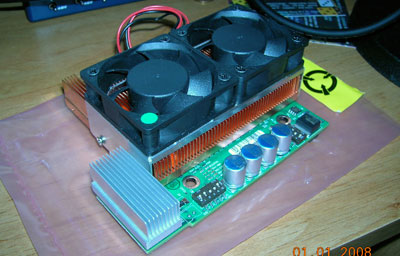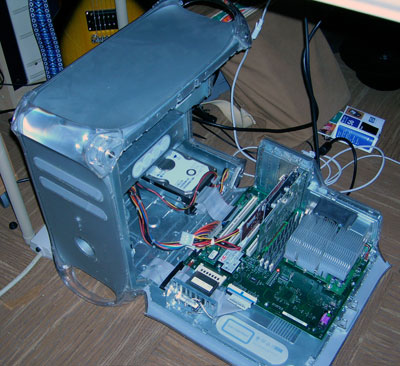
Dual 1.4 GHz G4 AGP processor upgrade
Company: FastMac
Price: $419.95
Why upgrade an older computer? Especially
one that’s over 4-5 years old? Why not just get a new Mac and keep up
with the Jones? I’ll tell you why. Macs are expensive. Especially
if you’re talking about replacing one older tower with another. The
price for a new Mac Pro without any bells and whistles is $2200. That’s bare
minimum and adding anything like hard drives (which you’ll need new ones of as
all new towers are using SATA instead of ATA) memory, wireless (yes the Mac Pro
does not come with an Airport 802.11x card), etc, is going to drive the price
up even more. You can certainly go cheaper than that. You can get an iMac or a
Mac Mini for less, but if you’re used to the expansion option you have with a
tower, remember that you’ll be forced to go to all external devices (which take
up more room AND cost more as well) with either one of those choices. If you
have options for upgrading your processor, and the cost does not exceed around
25% of the cost for a new machine, it can be more than worth it to extend the
life of your current computer for a few years.
If you’re computer is REALLY old, say before the advent of
the G3, then it just won’t be worth putting any real money into it. Bite the
bullet, get either an Intel Mac or at least a G4 PPC Mac (and then upgrade it!)
and join the ranks of the OS X family. On to the review.
First off, I owe Mike Lowdermilk
of FastMac an apology for how long it took me to write this review. I met with
him and expressed an interest in getting a dual 1.4 GHz G4 processor upgrade
kit from FastMac LAST Macworld and we played
telephone/email tag for a few months and it finally showed up in April just in
time for a medical crisis to hit the family. After that one thing leads to
another and here we are in December with no review written yet, Certain members
of the MyMac family (cough…Nemo…cough) started to remind me that the 2008
Macworld was coming up and any promised unfinished reviews needed to be
completed.
So there I was, a relatively new 2.16 GHz Core2Duo iMac
sitting in front of me all shiny and bright, and now I had to brush the cobwebs
off a 933MHz G4. I wasn’t looking forward to the amount of time I was going to
have to spend researching and testing and in the beginning, I was correct. It
was dreadfully dull. Trying to get benchmarks off a 5-6 year old computer when
a much faster computer is right in front of you is difficult. However I learned
something along the way and I’ll get to it eventually. But let’s talk about the
Processor upgrade from FastMac and the computer it went into.
As I said, the computer that I used for this review is a
standard Apple QuickSilver G4 tower with a 933 MHz G4
processor. Here are the basic specs:
Processor: PowerPC G4 @ 933 MHz (7455)
L1 Cache: 32k
L2 Cache: 256k
L3 Cache: 2048k (2 Mb)
Bus frequency: 133 MHz
Memory: 768 Mb of Ram
Graphics card: NVIDIA GeForce MX
with 64 Mb of dedicated Ram

This machine was the bee’s knees (as my grandmother used to
say) back in the day but is laughably slow now. It is capable of running 10.5
Leopard so since I had two identical 250 Gb hard
drives in it, it seemed to perfect way to start out
the test. So I wiped both drives, installed 10.4 Tiger on one and 10.5 Leopard
on the other. Put fresh installs of iLife 08 and class=SpellE>iWork 08 on each as well along with a licensed copy of the
latest version of QuickTime Pro. I also went out and got fresh copies of class=SpellE>XBench
(version 1.3) and Maxon’s
CineBench and put the old workhorse
through its paces. Unsurprisingly, the 933 didn’t fare so well against the
Intel iMac or the baseline 2.0 GHz G5 that Xbench uses.
The G4 is outmatched by the dual G5 benchmarks and woefully
slow compared to the Intel iMac. One thing I found interesting was the User
Interface test results between the Tiger and Leopard releases of OS X. Most of
the results are plus or minus 10% or so, well within the margin of error, but
the UI result is significantly lower in 10.5 than it is in 10.4 for the G4.
The Maxon Cinebench results were much the same. I don’t have
the results from a 2 core G5, but I do have them from an Intel Core2Duo iMac
and used that for a basis of comparison. One thing the Maxon test does is test
both processors separately and in a pair for rendering images. Naturally the
933 G4 being a single processor unit didn’t do that part of the test. The 933
G4 was hopelessly outclassed but the much newer Intel Mac and that shouldn’t
come as a surprise. I also ran a number of applications to test the speed of
the existing processor and would do the same for the new one once installed.
Next up was installing FastMac’s dual 1.4 GHz upgrade
processor. I wasn’t sure what to expect as far as the actual installation went.
I had read of other upgrades that involved re-using the heat sync from your
original processor or applying thermal grease on top and some of the
difficulties or damage that people had done in applying either too much or not
enough. FastMac’s upgrade was a breeze by comparison. The AGP upgrades include
a fan (or in the case of the dual 1.4 GHz model, two fans) to cool the processor
instead of the heat sync and I was originally concerned that it would make the
computer excessively noisy. Absolutely nothing to worry about, as the two fans
are so quiet that even with the case open, I couldn’t hear them. Of course the
fans installed in the QuickSilver G4 towers are
pretty noisy to begin with, so it’s possible that it just drowned out any noise
from the processor fan.
I first shut down the tower, removed the AC plug from the
back and all other external cables. After letting it cool down for about class=GramE>a hour, I removed the 933 G4 and set it off to the side and
slid into place the FastMac upgrade.
The specifications on the FastMac upgrade is as follows:
Processor: PowerPC G4 X 2 @ 1.4 GHz (7455)
L1 Cache: 32k
L2 Cache: 256k
L3 Cache: 2048k (2 Mb)
An odd thing about this upgrade that first
puzzled and alarmed me. When you do the “About this Mac†is the Apple
menu, it reports that you have two 0 GHz G4 processors. Apparently since Apple
never used this exact processor in any of their machines (the closest would be
the 1.467 Dualies), OS X is not quite sure what to
make of them. It runs great, just looks odd. Back to the
installation.
I installed the processor and restarted the Mac. Nothing. No
bong, no fans running, nothing. I started re-reading the literature that came
with the machine and looked at the switch settings on the processor itself.
Because this upgrade can be used with many different machines, you have to make
sure that the processor speed switches match up with the proper bus frequency
(in my case 133 MHz) and I had not done so prior to installation, DOH! I set it
to the proper speed and again started up the Mac. AH, now that was the sound I
was looking for.
I re-ran the Xbench and CineBench
tests that I had run before and here are the results:
style=’width:456.0pt;margin-left:4.4pt;border-collapse:collapse;mso-padding-alt:
0in 5.4pt 0in 5.4pt’>
|
style=’mso-bidi-font-weight:normal’>Xbench 1.3 results |
style=’font-size:10.0pt;font-family:Verdana’> |
|
|
|
|
|
|
style=’font-size:10.0pt;font-family:Verdana’> |
style=’font-size:10.0pt;font-family:Verdana’>2.0 G5 Benchmark |
style=’font-size:10.0pt;font-family:Verdana’>Intel iMac 10.5 |
style=’font-size:10.0pt;font-family:Verdana’>933 MHz G4 10.4 Tiger |
style=’font-size:10.0pt;font-family:Verdana’>933 MHz G4 10,5 Leopard |
style=’font-size:10.0pt;font-family:Verdana’>1.4 GHz Dual G4 10.4 Tiger |
style=’font-size:10.0pt;font-family:Verdana’>1.4 GHz Dual G4 10.5 Leopard |
|
style=’font-size:10.0pt;font-family:Verdana’> |
style=’font-size:10.0pt;font-family:Verdana’> |
style=’font-size:10.0pt;font-family:Verdana’> |
style=’font-size:10.0pt;font-family:Verdana’> |
style=’font-size:10.0pt;font-family:Verdana’> |
style=’font-size:10.0pt;font-family:Verdana’> |
style=’font-size:10.0pt;font-family:Verdana’> |
|
style=’font-size:10.0pt;font-family:Verdana’>Overall Result |
style=’font-size:10.0pt;font-family:Verdana’>100 |
style=’font-size:10.0pt;font-family:Verdana’>119.63 |
style=’font-size:10.0pt;font-family:Verdana’>46.62 |
style=’font-size:10.0pt;font-family:Verdana’>53.07 |
style=’font-size:10.0pt;font-family:Verdana’>94.61 |
style=’font-size:10.0pt;font-family:Verdana’>102.47 |
|
style=’font-size:10.0pt;font-family:Verdana’>CPU Test |
style=’font-size:10.0pt;font-family:Verdana’>100 |
style=’font-size:10.0pt;font-family:Verdana’>125.27 |
style=’font-size:10.0pt;font-family:Verdana’>45.65 |
style=’font-size:10.0pt;font-family:Verdana’>47.42 |
style=’font-size:10.0pt;font-family:Verdana’>73.78 |
style=’font-size:10.0pt;font-family:Verdana’>75.88 |
|
style=’font-size:10.0pt;font-family:Verdana’>Thread Test |
style=’font-size:10.0pt;font-family:Verdana’>100 |
style=’font-size:10.0pt;font-family:Verdana’>197.22 |
style=’font-size:10.0pt;font-family:Verdana’>40.8 |
style=’font-size:10.0pt;font-family:Verdana’>34.32 |
style=’font-size:10.0pt;font-family:Verdana’>99.49 |
style=’font-size:10.0pt;font-family:Verdana’>84.63 |
|
style=’font-size:10.0pt;font-family:Verdana’>Memory Test |
style=’font-size:10.0pt;font-family:Verdana’>100 |
style=’font-size:10.0pt;font-family:Verdana’>139.08 |
style=’font-size:10.0pt;font-family:Verdana’>34.67 |
style=’font-size:10.0pt;font-family:Verdana’>35.92 |
style=’font-size:10.0pt;font-family:Verdana’>32.92 |
style=’font-size:10.0pt;font-family:Verdana’>39.43 |
|
style=’font-size:10.0pt;font-family:Verdana’>Quartz Graphics test |
style=’font-size:10.0pt;font-family:Verdana’>100 |
style=’font-size:10.0pt;font-family:Verdana’>170.2 |
style=’font-size:10.0pt;font-family:Verdana’>52.03 |
style=’font-size:10.0pt;font-family:Verdana’>62.71 |
style=’font-size:10.0pt;font-family:Verdana’>64.31 |
style=’font-size:10.0pt;font-family:Verdana’>88.93 |
|
style=’font-size:10.0pt;font-family:Verdana’>OpenGL Graphics test |
style=’font-size:10.0pt;font-family:Verdana’>100 |
style=’font-size:10.0pt;font-family:Verdana’>175.78 |
style=’font-size:10.0pt;font-family:Verdana’>58.21 |
style=’font-size:10.0pt;font-family:Verdana’>61.87 |
style=’font-size:10.0pt;font-family:Verdana’>81.03 |
style=’font-size:10.0pt;font-family:Verdana’>82.63 |
|
style=’font-size:10.0pt;font-family:Verdana’>User Interface Test |
style=’font-size:10.0pt;font-family:Verdana’>100 |
style=’font-size:10.0pt;font-family:Verdana’>282.61 |
style=’font-size:10.0pt;font-family:Verdana’>41.21 |
style=’font-size:10.0pt;font-family:Verdana’>24.35 |
style=’font-size:10.0pt;font-family:Verdana’>56.84 |
style=’font-size:10.0pt;font-family:Verdana’>47.66 |
|
style=’font-size:10.0pt;font-family:Verdana’>Disk Test |
style=’font-size:10.0pt;font-family:Verdana’>100 |
style=’font-size:10.0pt;font-family:Verdana’>43.16 |
style=’font-size:10.0pt;font-family:Verdana’>70.27 |
style=’font-size:10.0pt;font-family:Verdana’>63.45 |
style=’font-size:10.0pt;font-family:Verdana’>57.03 |
style=’font-size:10.0pt;font-family:Verdana’>62.75 |
As you can see, the 933 G4 did very poorly against either
the benchmark dual G5 or the Intel iMac. The FastMac Dual G4 however scored
rather impressively considering that this is a much older design and that the
bus speed for the QuickSilver is much less than
either the G5 or the Intel iMac. The biggest surprise for me was how poorly the
Intel Mac did with the Disk Test as compared to either PPC machines.
Here are the results of the Maxon Cinebench tests with the
933 MHz and 1.4 GHz G4 processors and for comparison sake, my 2.16 GHz Intel
iMac.
style=’width:438.0pt;margin-left:4.4pt;border-collapse:collapse;mso-padding-alt:
0in 5.4pt 0in 5.4pt’>
|
style=’mso-bidi-font-weight:normal’>Maxon Cinebench results |
|
|
|
|
|
|
style=’font-size:10.0pt;font-family:Verdana’> |
style=’font-size:10.0pt;font-family:Verdana’>Intel iMac 10.5 |
style=’font-size:10.0pt;font-family:Verdana’>933 MHz G4 10.4 Tiger |
style=’font-size:10.0pt;font-family:Verdana’>933 MHz G4 10.5 Leopard |
style=’font-size:10.0pt;font-family:Verdana’>1.4 GHz Dual G4 10.4 Tiger |
style=’font-size:10.0pt;font-family:Verdana’>1.4 GHz Dual G4 10.5 Leopard |
|
style=’font-size:10.0pt;font-family:Verdana’>OpenGL |
style=’font-size:10.0pt;font-family:Verdana’>2930 |
style=’font-size:10.0pt;font-family:Verdana’>76 |
style=’font-size:10.0pt;font-family:Verdana’>131 |
style=’font-size:10.0pt;font-family:Verdana’>118 |
style=’font-size:10.0pt;font-family:Verdana’>195 |
|
style=’font-size:10.0pt;font-family:Verdana’>CPU render test |
style=’font-size:10.0pt;font-family:Verdana’>2267 |
style=’font-size:10.0pt;font-family:Verdana’>604 |
style=’font-size:10.0pt;font-family:Verdana’>609 |
style=’font-size:10.0pt;font-family:Verdana’>903 |
style=’font-size:10.0pt;font-family:Verdana’>900 |
|
style=’font-size:10.0pt;font-family:Verdana’>Multiple CPU render test |
style=’font-size:10.0pt;font-family:Verdana’>3655 |
style=’font-size:10.0pt;font-family:Verdana’>N/A |
style=’font-size:10.0pt;font-family:Verdana’>N/A |
style=’font-size:10.0pt;font-family:Verdana’>1665 |
style=’font-size:10.0pt;font-family:Verdana’>1672 |
|
style=’font-size:10.0pt;font-family:Verdana’>Muti-Processsor style=’font-size:10.0pt;font-family:Verdana’> Speedup |
style=’font-size:10.0pt;font-family:Verdana’>1.61 |
style=’font-size:10.0pt;font-family:Verdana’>N/A |
border-left:none;border-bottom:solid windowtext 1.0pt;border-right:solid windowtext 1.0pt; mso-border-top-alt:solid windowtext .5pt;mso-border-left-alt:s |

Leave a Reply
You must be logged in to post a comment.